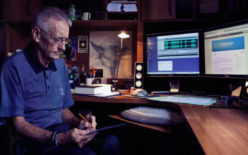Introduction
During the period November 17-21, 2003, I traveled with Team 7 during their site visits to American Airlines and United Airlines headquarters. I wrote an MFR to “list certain details from Mr. Kara’s perspective.” Those details included transponders, cockpit vision, flyability, ACARS, and ASD (Aircraft Situation Display). Here I focus primarily on the hijacker seating, with brief comment on other items of interest.
Hijacker Seating
Here is what I wrote:
The hijacker seating arrangement of 1-2-2, with pilot to the front on the B757s was clearly pre-meditated and different from the 2-1-2 seating arrangement aboard the B767s with the pilot in the middle. On the B757 there is only one cabin crew (one of four or five), the purser, sitting forward immediately aft the cockpit. On the B767, as many as three (of nine) sit forward immediately aft the cockpit.
This is an example of the detailed planning for the attack and is based on information that would have been obtained from the several cross-country orientation flights taken by the hijacker pilots and associates.
My Assessment
I estimate that the plan was to have each pilot seated as close to the cockpit as tactically convenient, based on availability of seating when reservations were made. The B767 crew arrangement, however, dictated that accomplices be seated forward of the hijacker pilot.
Other Brief Comments
According to my MFR, the senior pilots for both United and American assessed that the UA 175 hijacker pilot likely did not see AA 11 fly into the World Trade Center north tower, but “it was near certain that he would have immediately seen the fire/plume.”
According to the senior pilots, “The cockpits of the B757 and B767 are virtually interchangeable in their essential elements. Both are “easy to fly.”
The United Airlines alert to UA 93 about cockpit intrusions was sent at 1324:24Z. UA 93 crew asked for confirmation at 1326:10Z. That was the last crew communication from the cockpit. In a recent update to the 9/11 Report Card, I downgraded Herndon Center for not following up on a Boston Center request to notify pilots in the air to increase cockpit security. That Boston request was made at 9:15, nearly 10 minutes before the warning was sent to UA 93.
The Aircraft Situation Display was not time sensitive and refreshed each minute or more. Its sensitivity allowed United to maintain continuity on UA93, but did not allow American to gain situational awareness of AA 77.
